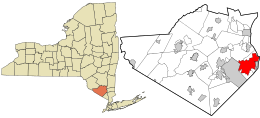West Point, NY
| West Point, New York | |
|---|---|
| CDP | |

Aerial view of West Point, 2013. West Point is at center on the near (western) side of the river. Highland Falls is at right; Cold Spring is at left, across the river in Putnam County.
|
|
 Location in Orange County and the state of New York. |
|
| Location in the state of New York | |
| Coordinates: 41°23′N 73°58′W / 41.383°N 73.967°WCoordinates: 41°23′N 73°58′W / 41.383°N 73.967°W | |
| Country | United States |
| State | New York |
| County | Orange |
| Area | |
| • Total | 25.1 sq mi (64.9 km2) |
| • Land | 24.3 sq mi (63.0 km2) |
| • Water | 0.7 sq mi (1.9 km2) |
| Population (2010) | |
| • Total | 6,763 |
| Time zone | Eastern (EST) (UTC-5) |
| • Summer (DST) | EDT (UTC-4) |
| ZIP codes | 10996-10997 |
| Area code(s) | 845 |
| FIPS code | 36-80747 |
West Point is the oldest continuously occupied military post in the United States. West Point was established in 1775 by George Washington who considered it the most important strategic position in America. Until January 1778, West Point was not occupied by the military. On January 27, 1778, Brigadier General Samuel Holden Parsons and his brigade crossed the ice on the Hudson River and climbed to the plain on West Point and from that day to the present, West Point has been occupied by the United States Army. It comprises approximately 16,000 acres (6,500 ha) including the campus of the United States Military Academy at West Point, which is also frequently called "West Point". It is a Census Designated Place (CDP) located in the Town of Highlands in Orange County, New York, located on the western bank of the Hudson River. The population was 6,763 at the 2010 census. It is part of the New York-Newark-Jersey City, NY-NJ-PA Metropolitan Statistical Area as well as the larger New York-Newark, NY-NJ-CT-PA Combined Statistical Area.
West Point, (then Fort Clinton) was a fortified site during the Revolutionary War. Originally picked because of the abnormal S-curve in the Hudson at this point, it was founded by military engineer, Polish Colonel Tadeusz Kościuszko. It was manned by a small garrison of Continental soldiers through the entirety of the war. A great iron chain was laid across the Hudson at this point in order to impede British Navy vessels, but it was never tested by the British. The site comprised multiple redoubts, including Fort Putnam, which is still preserved in a Revolutionary-period design.
In perhaps the most infamous act of treason in American history, General Benedict Arnold attempted to turn the site over to the British Army in 1780 for a bribe consisting of a commission as a Brigadier General in the British Army and a cash reward of £20,000 (about $1.3M in 2009 dollars). However, Arnold's plot failed when British Major John André was captured as a spy by the Americans. Arnold received a decreased cash reward of £6,000 (roughly $350,000) but was commissioned as a Brigadier General in the British Army.
...
Wikipedia

